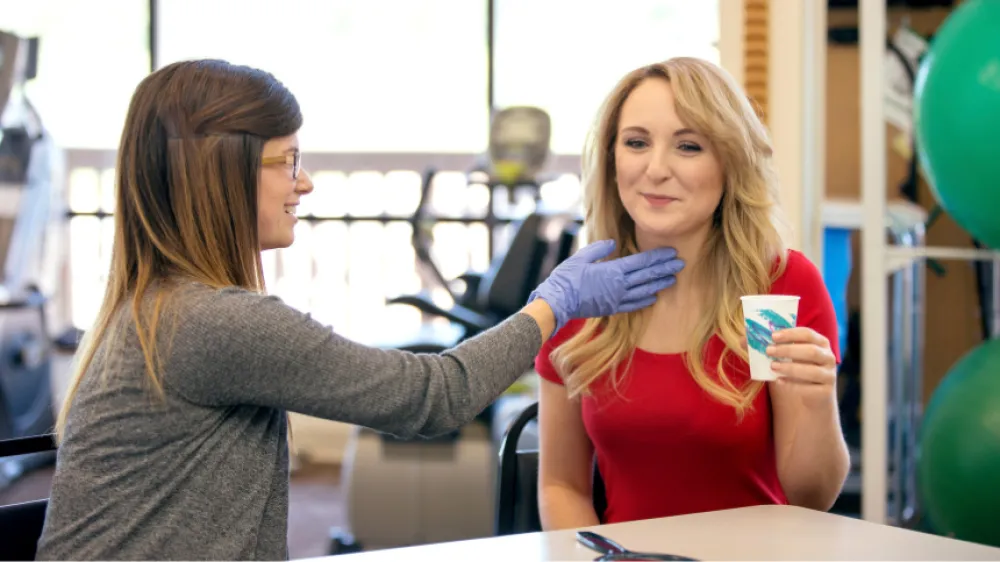Providing your location allows us to show you nearby locations and doctors.
Can speech therapy help with Parkinson’s disease?

04/22/2024
Speech therapy can help people with Parkinson’s disease manage voice and swallowing concerns so they can stay as social, healthy and safe as possible
By Rosemary Griffin, MA, CCC-SLP, Director of Speech Pathology, Nuvance Health
Parkinson’s disease can cause speaking and swallowing problems. Trouble communicating can be very frustrating for people and lead to isolation. Trouble swallowing can lead to additional, serious medical problems such as malnutrition and aspiration — or getting food or liquids stuck in the airway or lungs.
While there is no cure for Parkinson’s disease, there are ways to manage symptoms so you or a loved one with this neurological condition can stay independent and have a good quality of life as much as possible.
Here is how speech therapy can help people manage voice and swallowing challenges associated with Parkinson’s disease.
What is Parkinson’s disease?
Parkinson’s disease is a progressive movement disorder and the second most common neurodegenerative disease in the United States. About 60,000 Americans are diagnosed with Parkinson’s disease each year, and 10 million people are living with it worldwide.
Parkinson’s disease causes trembling of hands, arms, legs, jaw and face, and poor balance and coordination. As symptoms worsen, individuals may have difficulty chewing, swallowing or speaking, talking or walking.
How does Parkinson’s disease affect speech?
Dysarthria is a combination of impairments in articulation, speech rate, timbre or resonance and volume. Someone with dysarthria from Parkinson’s disease may lack emphasis and emotion, speak in a low volume, sound muffled or trail off.
Parkinson’s disease may also affect face and mouth muscle movement, which can then affect how someone communicates.
Finally, a relatively smaller group of people with Parkinson’s disease may experience cognitive changes that impact memory, planning and word retrieval.
Related content: Brain health supplements: What you need to know
How does Parkinson’s disease affect swallowing?
People with Parkinson’s disease often experience swallowing difficulty, called dysphagia. Dysphagia can cause dehydration, malnutrition and aspiration, which is when food or liquid enters the airway or lungs by accident. Aspiration pneumonia is the leading cause of death in people with Parkinson’s disease.
What is speech therapy for Parkinson’s disease?
Talk with your neurologist to determine if you will benefit from speech therapy for Parkinson’s disease. Your neurologist may recommend you see a speech-language pathologist, who can provide the following speech services:
- Evaluate speech, language and voice, which includes a computerized assessment of vocal parameters.
- Introduce speech interventions to increase loudness and intelligibility (understandability). At Nuvance Health, individualized treatment may include the Lee Silverman Voice Treatment — LOUD® program or the Parkinson’s Voice Project SPEAK OUT® program.
- Weekly coaching, speaking practice and voice-enhancing strategies through the LOUD Crowd® support group.
The Parkinson’s Voice Project has awarded grants to Nuvance Health’s Norwalk Hospital, Northern Dutchess Hospital, Putnam Hospital and Vassar Brothers Medical Center for supplies and training to care for patients with Parkinson’s disease.
What is swallowing therapy for Parkinson’s disease?
Therapy for swallowing problems associated with Parkinson’s disease aims to address motor weakness or compensate for neuromuscular changes to maintain your ability to safely eat and drink.
A speech-language pathologist will evaluate your swallowing by observing how you consume food, liquids and medications. They pay attention to things like coughing, throat clearing and changes in voice quality.
Your speech-language pathologist may also recommend you have a modified barium swallow study. First, you will drink and eat liquid and solid foods mixed with barium. Then the speech-language pathologist and a radiologist will view how you swallow through videofluoroscopic images.
Barium studies show specific aspects of swallowing affected by Parkinson’s disease so the speech-language pathologist can create a personalized treatment program. The program may include certain food textures and liquid thicknesses, so swallowing is as safe as possible.
Some Nuvance Health locations also offer Fiberoptic Endoscopic Evaluation of Swallowing (FEES) as an alternative or supplement to the modified barium swallow study. This procedure allows direct viewing of the larynx and pharynx during speaking and swallowing. Like the modified barium swallow study, it will reveal the swallowing impairment so the speech-language pathologist can recommend techniques to minimize the risk of aspiration.
What is cognitive-linguistic therapy for Parkinson’s disease?
A speech-language pathologist evaluates someone’s cognitive-linguistic skills through standardized tests and quality-of-life ratings. Based on the results, they will develop a personalized treatment plan for someone with Parkinson’s disease to compensate for cognitive difficulties and to engage caregivers as effective communication partners.
The bottom line: Speech-language pathologists can help people with Parkinson’s disease manage speech and swallowing concerns so they can maintain their independence, health and wellness as much as possible.
Learn more about Nuvance Health’s speech therapy and request an appointment.